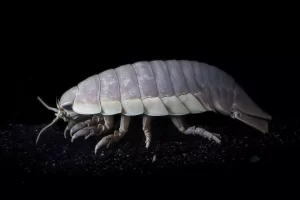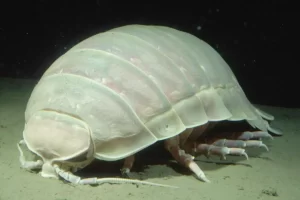The pillbug — that roly poly backyard bug — has a colossal cousin that lives in the ocean’s darkest depths. The giant isopod (Bathynomus giganteus) roams the deep seafloor feasting on fish carcasses and other debris that fall from above.
Of thousands of species of isopods, the giant isopod is the largest — and among the most mysterious. Though it was discovered in 1879, scientists have yet to do extensive studies on this animal’s biology and behavior. More research will help us better understand this fascinating animal.


Anatomy
The giant isopod is a crustacean — a distant cousin of crabs. Like all crustaceans, it has jointed legs and a hard exterior called an exoskeleton. Three segments make up its body: the head (cephalon), the thorax (pereon) and the abdomen (pleon).
Its 14 legs help it explore the ocean floor. To swim, it uses a fan-like tail called a uropod and fluttering swimmerets called pleopods. Pleopods also help the giant isopod with respiration! It senses its surroundings with its large eyes and two sets of antennae: one short pair, one long pair. These spindly sensors reach nearly half the length of its body!
Size
A giant isopod grows up to 16 inches (40 cm). This is much bigger than its terrestrial relative the pillbug, which is less than an inch (2.5 cm) long. Its large size makes it an example of deep-sea gigantism. This term describes the phenomenon of deep-sea animals evolving to a much larger size than their relatives that live in other habitats.
Although scientists aren’t exactly sure what causes deep-sea gigantism, the two rules that are commonly used to explain it are Kleiber’s rule and Bergmann’s rule. Kleiber’s rule states that larger animals are generally more efficient. Bergmann’s rule states that sea animals who dwell in colder water are larger in size.
Habitat
The giant isopod lives in an extreme habitat: the deep sea. It can live more than 1600 feet (500m) below the ocean’s surface — dark depths with less than one-millionth of the sunlight found at the surface.
Diet
What’s for lunch on the deep seafloor? With sparse plant and animal life on the seafloor, the giant isopod evolved to be a scavenger. And like many animals that live in the deep sea, it eats falling debris. It will scavenge for falling fishheads, crab bits, marine snow or marine worms. If it gets lucky, a giant isopod will enjoy a whale fall feast — a special occasion since large carcasses don’t always sink down to the deep.
Cool facts
- The giant isopod is one of an estimated 10,000 species of isopods!
- The giant isopod has no spine. It’s a crustacean — cousins of crabs and shrimp.
- Isopods can be tiny or huge. The giant isopod grows up to 16 inches — making it the largest isopod — while the smallest isopods are just millimeters long.
- Ocean-dwelling isopods have swimming limbs, called pleopods, that they also use for respiration.
